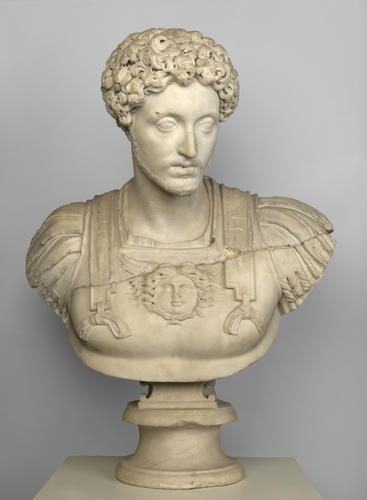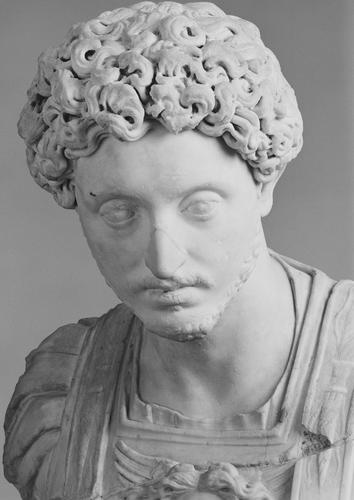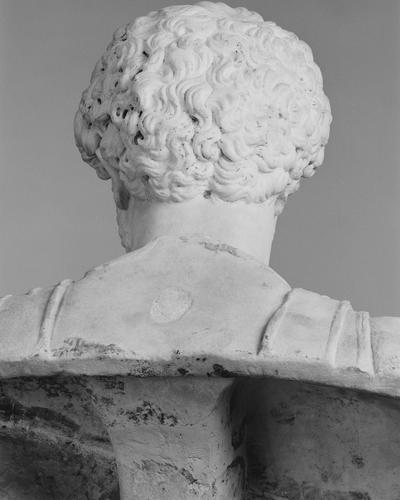Marcus Aurelius 139-150 AD
Marble | 85.0 cm (including base/stand) | RCIN 1296
-
This marble bust of a male is a portrait of the Roman emperor Marcus Aurelius as Crown Prince. It is thought to be from the period between 139-144 and 161 AD, when depictions of a maturing crown prince shown with heavier facial hair replaced earlier, more childlike and clean-shaven images. Marcus Aurelius is depicted with a meditative expression, facing slightly down. His hair is arranged in an intricate pattern of spiralling curly locks and wearing military armour with an appliqué of Medusa in the centre. These images were used as propaganda to promote the values and interests of the ruling dynasties, and were widely disseminated throughout the empire. Recent research suggests that this is a replica of Marcus Aurelius second official portrait as crown prince and that it was carried out circa 147 AD to mark his ascension to the tribunician power. This marble portrait of Marcus Aurelius together with that of his consort, Faustina the Younger (RCIN 1299), came from the Gonzaga collection in Mantua. They were sold by Duke Vincenzo II of Mantua to Charles I some time after 1625. It is thought that the marble portrait bust of a youth with a wreath and the portrait of Antinous (RCIN 1297 and 1298 respectively), also came from this collection. During his reign, Charles I put together an important collection of classical antiquities. Five outstanding Roman marble portrait busts (RCIN 1296, 1297, 1298, 1299 and 1300) dating from the 2nd century AD, which once belonged to Charles I, remain today in the Royal Collection. In a period when collecting antiquities became fashionable - although it remained exclusive to the very wealthiest because of the cost and rarity of the pieces - Charles I intended to imitate the grand collections of Renaissance princes in the continent. After his execution in 1649, Charles I’s collection was dispersed or sold, and in the preceding years of Civil War, from 1642, many of the works were damaged during anti-royalist riots, as it is the case with these marble portraits. When the monarchy was restored in 1660, Charles II revived his father’s tradition for collecting antiquities and during a diplomatic visit to the Dutch Republic that year he was presented with a Roman marble portrait bust of a lady (RCIN1295), also in the Royal Collection. These six Roman marble portraits remained unnoticed for a period of almost two hundred years until they were re-evaluated in 1934 and put on display as a group, first in the Orangery and later on in the Stone Hall, at Hampton Court Palace.
Provenance
Acquired by Charles I
-
Medium and techniques
Marble
Measurements
85.0 cm (including base/stand)
66.0 cm (excluding base/stand)
Bibliographic reference(s)
Elizabeth Angelicoussis / The Stuart Legacy, ancient busts at Hampton Court Palace / Mitteilungen des Deutscehn Archaologischen Instituts Romische Abteilung / Band 110 / 2003 / Verlag Philipp von Zabern / Mainz am Rhein pp57 - 92















